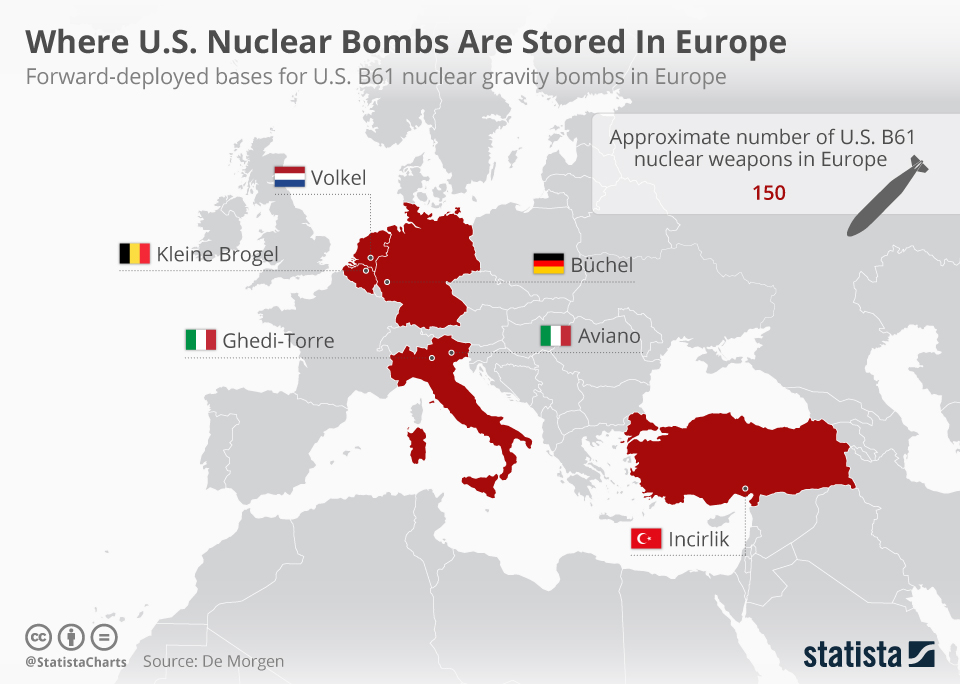At the peak of the Cold War nuclear arms race in 1986, the number of nuclear warheads globally was estimated to total to almost 65,000. in 2014 there were about 10,000 active warheads.
A NATO-affiliated body recently released and subsequently deleted a document that apparently confirmed something that has been suspected for a long time – U.S. nuclear weapons are being stored at air bases in several European countries. The document was compiled in April and a copy was published on Tuesday by Belgian newspaper De Morgen which states that B61 nuclear bombs are currently stored at six bases in Europe.
They are Kleine Brogel in Belgium, Büchel in Germany, Aviano and Ghedi-Torre in Italy, Volkel in the Netherlands and Incirlik in Turkey. The presence of the weapons stems from an agreement during the Cold War in the 1960s aimed to deter the Soviet Union and convince the countries involved that starting their own nuclear weapons programs was not necessary.
The B61 is a low to intermediate-yield strategic and tactical thermonuclear gravity bomb which features a two-stage radiation implosion design. It is capable of being deployed on a range of aircraft such as the F-15E, F-16 and Tornado. It can be released at speeds up to Mach 2 and dropped as low as 50 feet where it features a 31-second delay to allow the delivery aircraft to escape the blast radius.
 You will find more infographics at Statista
You will find more infographics at Statista
Nuclear weapons – Statistics & Facts
Published by Erin Duffin, Apr 29, 2019
Though an ever-present danger, fears of nuclear war have heightened with North Korea’s possession of nuclear weapons and the country’s intensification of missile tests. Leader Kim Jong Un also appears willing to test the international mood surrounding his new power with increasingly aggressive rhetoric. With the international community nervously watching on, U.S. President Trump has countered these comments with an aggressive tone of his own. Nuclear tensions appear at a high not seen since the Cold War. The difference now is Trump’s twitter handle provides as much of an insight into the thoughts of the man with his hand on the button as his assertive United Nations speech on the North Korean threat.
Despite continued attention on previously non-nuclear states seeking to develop nuclear weapons, the lion’s share of the world’s nuclear arsenal is still controlled by two countries. The lasting effects of the Cold War mean that together the United States and Russia control more than 90 percent of total nuclear warheads worldwide. Russia slightly outnumbers the United States with an estimated 7,000 warheads to the United States’ 6,800.
The two countries with the largest modern arsenals are also most responsible for the most nuclear tests since testing began in 1945. Between 1945 and 2015 the United States conducted 1,032 nuclear tests. The corresponding figure Russia, when including the USSR, is 715. Though Russia and the United States hold a similar amount of warheads, the United States commits a considerably higher amount of financial resources to their program each year. In 2011, the United States more than tripled Russia’s financial input, spending 34 billion U.S. dollars to Russia’s 9.8.
The military budget from 2013 to 2022 for programs related to nuclear weapons and nuclear warfare suggests the United States view offense as the best form of defense. While the United States plans to spend around 97.44 billion U.S. dollars on missile defenses, the planned spend on nuclear forces will exceed 390 billion between 2013 and 2022. This spending breakdown reflects the reality of tactics in nuclear warfare where full-scale conflict between two nuclear states will likely end in mutually assured destruction. As Nobel Prize-winning physicist James Franck who worked on the Manhattan Project stated, “In no other type of warfare does the advantage lie so heavily with the aggressor”.
The danger of mass destruction is present in an unstable state or group in possession of just one nuclear weapon. The nature of an attack by nuclear warhead renders domination through numbers somewhat ineffective leaving even global superpowers such as the United States and China vulnerable. As such, the global community has watched the nuclear development of Iran and North Korea with great concern. The Nuclear Security Index rates the risk from North Korea and Iran the highest among the countries in possession of nuclear material. Despite the attention, North Korea have continued their pursuit and over the last five years have significantly increased the number of ballistic missile tests they are conducting.
The terrifying consequences of nuclear weapons mean many countries and civil organizations are committed to the reduction or abolition of nuclear weapons around the world. These attempts have been somewhat successful in regards to reducing the number of nuclear warheads. At the peak of the Cold War nuclear arms race in 1986, the number of nuclear warheads globally was estimated to total to almost 65,000. By the same analysis, there were just over 10,000 active warheads in 2014. As mentioned, the instable nature of global politics means that the number of parties in control of nuclear warheads is of greater concern than the number of warheads themselves.
This text provides general information. Statista assumes no liability for the information given being complete or correct. Due to varying update cycles, statistics can display more up-to-date data than referenced in the text.



